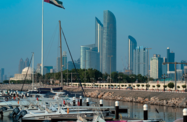New developments in the logistics sector, alongside an increase in non-oil trade, are expected to keep Abu Dhabi’s economy on track for moderate expansion in the coming year, with plans for further diversification set to deliver increasingly balanced growth.
Overall economic growth is expected to be 3.9% for 2012, according to the Abu Dhabi Department of Economic Development (DED), down from 6.8% last year. However, growth in non-oil industries should remain steady for the year at 5.5%, supported by activity in the financial sector, manufacturing and transport, Mohammad Omar Abdullah, the undersecretary of the DED, told local media.
Abu Dhabi has targeted non-oil growth in line with its bid to diversify the emirate’s economy and reduce dependence on oil revenue. Initiatives include a plan to increase non-oil exports from 1% of GDP, which is the current figure, to 11% by 2030.
Indeed, the total value of the emirate’s non-oil merchandise trade increased by 27.7% in 2011 to reach Dh139.42bn ($37.96bn), according to a report published in August by the Statistics Centre – Abu Dhabi. Exports made up 8.2% of the total, although they were down 1.1% on the previous year.
The rise in trade, led by machinery and transport equipment, manufactured goods and chemical products, spells good news for the emirate’s logistics sector, which is benefitting considerably from increased traffic through the newly-opened Khalifa Port. The facility, which began operating in September, replacing Mina Zayed as the emirate’s primary cargo port, has a current handling capacity of 2.5m twenty-foot equivalent units (TEUs) per year. Its phased development will see handling capacity increase to 5m when the next stage is completed, with a final target of 15m set for 2030.
Manufacturing, viewed as a key component of non-oil trade, is also earmarked for further growth in the coming years following the completion of the Khalifa Industrial Zone Abu Dhabi (Kizad).
More than 40 industry players have already signed up for plots at the industrial zone, with demand coming primarily from the aluminium and steel industry. Other tenants include Brasil Foods, the world’s largest poultry exporter, and logistics firm Al Batha Trading & Industry Group, which signed a 50-year lease on a 27,511-sq-metre plot in March. The emirate will be hoping that its attractions, led by easy access to the rest of the Gulf and a low-cost operating environment, bring more companies to the zone. Incentives include zero personal and corporate income taxes, and 100% repatriation of capital and profit for foreign investors.
Abu Dhabi’s banking sector also received a boost this year following a move by the UAE’s Central Bank to introduce new regulations in September aimed at managing the sector’s exposure to government-related entities. The regulatory change, which was praised by the IMF, prevents aggregate lending to local governments and state entities from exceeding 100% of a bank’s capital base, while also capping lending to individual borrowers at 25%.
The changes, which were announced in April, are expected to reduce the potential for concentration of risk within the sector. In its Article IV staff report published in May, the IMF said limits such as those introduced by the UAE Central Bank were “key” to the future of the sector, shielding the banking system from risks associated with government-related entities.
A more conservative approach, which permeated the UAE’s overall economic performance in 2012, meant banks saw little growth in lending, although profits were generally up on 2011. The National Bank of Abu Dhabi (NBAD), the emirate’s largest bank by assets, beat analysts’ estimates with net profit reaching Dh1.12bn ($305m) in the third quarter, up 9% on the second quarter and 7.6% y-o-y.
While the second-largest lender, Abu Dhabi Commercial Bank, posted a 3% decline in third-quarter net profit compared to third-quarter 2011, First Gulf Bank announced a 4% rise in quarterly profits and a 15% y-o-y increase, giving it a third-quarter net profit of Dh1.05bn ($286m). Abu Dhabi Islamic Bank also exceeded expectations by posting a 3% y-o-y rise in third-quarter net profits.
While growth in 2012 has been more subdued than last year, Abu Dhabi’s economy is expected to continue expanding into 2013.

